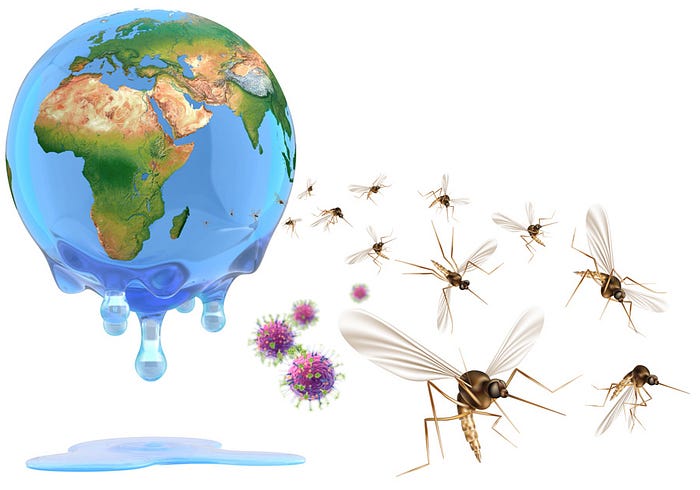
Impact of Climate Change on Dengue Fever and Other Neglected Diseases
Introduction
Climate change is having far-reaching consequences in various aspects of our lives, including public health. One of the most significant impacts of climate change is the alteration in the distribution and transmission patterns of infectious diseases, especially neglected tropical diseases such as dengue fever. In this blog, we will explore how climate change affects the prevalence of diseases like dengue fever and the measures taken to address these changing dynamics.
The Challenge of Neglected Diseases
Neglected tropical diseases (NTDs) are a group of infections that disproportionately affect marginalized populations in low-income countries. These diseases often receive insufficient attention and resources due to their prevalence in impoverished communities with limited access to healthcare services and funding.
Understanding Dengue Fever
Dengue fever is a mosquito-borne viral infection caused by the dengue virus. It is primarily transmitted by Aedes mosquitoes, primarily Aedes aegypti, and to a lesser extent, Aedes albopictus. Dengue can manifest as mild flu-like symptoms or progress to severe, potentially life-threatening conditions, such as dengue hemorrhagic fever and dengue shock syndrome. The World Health Organization (WHO) estimates that dengue infects over 390 million people annually, with a significant number of cases leading to severe outcomes.
Unique Characteristics of Aedes Mosquitoes
The transmission of dengue fever and other diseases by Aedes mosquitoes is influenced by their unique characteristics:
- Daytime Feeders: Aedes mosquitoes are primarily active during the day, particularly in the early morning and late afternoon, which is different from many other mosquito species that are active during the evening or at night.
- Urban and Peri-urban Habitats: Aedes mosquitoes are well-suited to urban and peri-urban environments, often breeding in artificial containers and water storage vessels found near human habitation. This behavior increases their proximity to human populations.
- Short Flight Range: Aedes mosquitoes typically have a relatively short flight range, staying within a few hundred meters of their breeding sites, which can lead to localized outbreaks.
- Multiple Feeding on Different Hosts: Aedes mosquitoes are known to take multiple blood meals during a single gonotrophic cycle, increasing the potential for viral transmission.
- Vector for Multiple Diseases: Aedes mosquitoes are vectors for various diseases, including dengue, Zika virus, chikungunya, and yellow fever, making them significant in the transmission of viral illnesses.
- Infectious for Life: Once an Aedes mosquito becomes infected with the dengue virus, it can remain infectious for life, setting it apart from other mosquito species.
Climate Change and Dengue Fever
Climate change significantly influences the prevalence and distribution of dengue fever:
- Altered Mosquito Habitats: Rising temperatures and changing precipitation patterns can expand the geographical range of Aedes mosquitoes, which thrive in warm, humid environments.
- Extended Transmission Season: Warmer temperatures can prolong the mosquito breeding season, increasing the risk of dengue transmission throughout the year.
- Extreme Weather Events: More frequent and severe weather events associated with climate change, such as flooding, create ideal breeding conditions for Aedes mosquitoes and lead to increased dengue outbreaks.
- Human Migration: Climate change can force human populations to migrate due to environmental changes, displacement, or loss of livelihoods, introducing dengue to new areas and increasing the likelihood of epidemics.
The Role of Climate Change
Climate change is driven by various factors, including increased greenhouse gas emissions, deforestation, and changing weather patterns. The resulting shifts in temperature and precipitation patterns have profound effects on the distribution of infectious diseases. These include:
- Vector Expansion: Warming temperatures and altered humidity levels can expand the geographic range of disease-carrying vectors, like Aedes mosquitoes.
- Seasonal Shifts: Climate change can lead to extended transmission seasons for diseases like dengue, with mosquitoes active throughout the year.
- Extreme Weather Events: More frequent and severe weather events can create breeding grounds for disease vectors and disrupt disease control efforts.
- Ecological Changes: Changes in climate can alter ecosystems, affecting the behavior and distribution of disease vectors and reservoirs.
- Human Migration: Climate-induced migration can introduce diseases to new areas, increasing the risk of epidemics.
Measures to Address Climate-Induced Changes
Efforts to combat the impact of climate change on diseases like dengue fever include:
- Research and Development: Ongoing research into new treatments, diagnostics, and vector control strategies that can adapt to changing disease patterns influenced by climate.
- Strengthening Health Systems: Collaborating with governments and organizations to bolster healthcare infrastructure in affected regions, enhancing surveillance, diagnostics, and treatment capacities to respond more effectively to disease outbreaks influenced by climate change.
- Capacity Building: Working with partners to build local research and medical capacity, ensuring that endemic regions have the knowledge and resources needed to combat diseases like dengue fever in changing climates.
- Advocacy and Awareness: Advocating for policies and resources to support the fight against NTDs in the context of climate change, raising awareness about the importance of addressing neglected diseases as part of a broader climate change mitigation strategy.
Conclusion
Climate change is affecting the distribution and prevalence of diseases such as dengue fever, particularly in marginalized communities. Understanding the unique characteristics of Aedes mosquitoes and their role in disease transmission is crucial to public health efforts. It is essential to address these challenges through research, strengthened health systems, local capacity building, and advocacy. By doing so, we can work towards mitigating the effects of climate change on public health and ensuring that even the most vulnerable communities have access to the tools and treatments they need to combat diseases like dengue fever effectively. In a world where the climate continues to change, our ability to adapt and respond is our greatest hope in the battle against these neglected diseases and the broader challenges posed by climate change.
